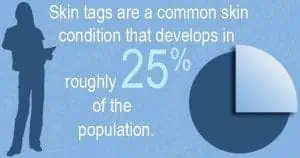
As you have grown older, you may have noticed that your skin has formed small, soft protrusions on your arms, neck, chest, or groin. These benign features are called skin tags, a common skin condition that develops in roughly 25% of the population. Often due to genetic predisposition, skin tags do not pose a threat to a person’s health, but can make patients self-conscious about the appearance or texture of their skin. As a result, many people will visit dermatologist clinics and research different skin tag removal products and methods. However, to discover the best course of action for you and your skin, it is important to understand why skin tags form and how they are best treated.
About Skin Tags
Dermatologist specialists believe that skin tags develop as a result of friction between clothing and skin, or two adjacent areas of skin; the latter is usually seen when the protrusions develop in the underarm or on the eyelid. Because of this, skin tags are more likely to develop in obese patients, those who are middle-aged, and the elderly. In some cases, however, skin tags can develop in children, pregnant women, and people with Crohn’s disease.
Skin tags are usually flesh-colored and can range in size from less than 1 millimeter to as large as a grape. Some patients may mistake them for cancerous lesions (a legitimate concern, as more than 3.5 million nonmelanoma cancers are diagnosed every year in the United States), but this mistake is unlikely, as skin tags can be distinguished by a small stalk connecting them to the body. They can sometimes become caught on clothes, but otherwise should not be painful; if a patient does experience pain and other unusual symptoms emerge, a dermatologist will likely have them excised and tested to ensure that they are not nevi, or atypical moles. These atypical moles can mean that a patient has a higher chance of developing melanoma, a deadly skin cancer characterized by the overproduction of pigment-producing cells. However, this is highly unlikely in most cases.
Skin Tag Removal Procedures
Because skin tags are benign, they typically are not removed unless they are uncomfortable or displeasing to the patient. While some home recipes claim to be able to remove skin tags with skin tag removal products, such as apple cider vinegar, effective results can only be achieved through surgery. In this procedure, a dermatologist will use a blade, scissors, liquid nitrogen or electric cautery; a local anesthetic can be used if necessary. The surgery is curative, but more skin tags may form over time. Fortunately, almost any dermatologist can and will perform this treatment, making it easy for many patients to find the care they need at a local dermatologist clinic.
While skin conditions like skin tags may not be attractive, in most cases they are a normal development that poses no threat to a person’s health. If you want to remove these protrusions, don’t waste your time researching skin tag removal products or home remedies; instead, schedule an appointment with your dermatologist to discuss surgery today.





